Exploring Antique Technologies
By Kary Pardy
You close your eyes, give the globe a hard spin, and jab your finger at it. Wherever your finger lands is your future homeland, your next vacation destination, or the country that you’ll write a report about for your next paper. Most of us have played this game and even today, when some question Earth’s roundness, globes are a visible reminder to view our planet as a whole, as well as a poignant record of the people that move across it.
Globes as we know them date from the 15th century, and were likely created to solve scale problems caused by two-dimensional maps. Whereas a flat map would distort countries (the large size of Greenland being a famous example), globes allowed for accurate maps that were just scaled way down in size. From the beginning, globes were special, individual works of art that portrayed our planet with flourishes, such as fantastically illustrated sea monsters in unknown lands. Today’s globes are more practical, but still sometimes acquiesce to attractive compass roses and fine wood stands. But beyond simply looking pretty, globes are packed full of important information about the world and how we see it at any given time. We can see religious beliefs and legends change, the discoveries of New Worlds, shifting political boundaries and national identities, and scientific progress. They are time capsules and works of art in ways that few other collectibles can be.

At the beginning. The Erdapfel, (“Earth Apple” or “potato” in some colloquial translations), is the oldest surviving globe and dates from 1492. It is a laminated linen ball that was first molded and then mounted on a wooden frame. The Erdapfel is traditionally attributed to Martin Behaim, but it was the work of a dedicated team of artisans, including artist Georg Glockendon, painter Hans Storch, and a scribe who added in the approximately 2,000 place names. This famous globe is covered in beautiful detail and is decorated with over one hundred miniature objects and figures including saints, kings, flags, animals, legendary beasts, and seas filled with ships. The map itself is not much more than a large landmass of Eurasian continent with surrounding islands, and it was inaccurate even at the time it was made, but it offers a glimpse into the culture that created it, one that believed in, and mapped, legends such as the phantom Saint Brendan’s Isle. The Erdapfel is currently in the collection of the German National Museum.
From the Erdapfel’s sea serpents to other fanciful creatures, the third oldest terrestrial globe, the noted copper Hunt-Lenox Globe, ca. 1510, reads “Hic Sunt Dracones,” translated into the famous “Here be dragons.” The phrase hovers around the east coast of Asia, and may refer to Indonesian Komodo dragons or something more magical, depending on your preference. Relatively recently, in 2012, a near twin to the Hunt- Lenox globe appeared on the scene through the work of Stefaan Missinne. Engraved on an ostrich egg and strikingly similar to the Hunt-Lenox globe down to spelling errors and wave patterns, Missinne posited that the Hunt-Lenox globe was cast from the egg. The globe is believed to date from 1504 and now holds the title of the oldest globe to depict the New World and the warning about dragons.
New Englander James Wilson is credited with being the first American globe maker. He was active in the early 19th century and scholars suggest that the wide variety of skills needed to make a globe (illustration, measurement, printing, casting, wood turning and joinery) prohibited Americans from stepping onto the scene earlier.
Wilson was a farmer and blacksmith in New Hampshire and Vermont before pursuing globes. Legends attribute his inspiration to a pair of globes at Dartmouth College or the early Vermont mapmaker James Whitelaw, but regardless he constructed his first globe of solid wood with continents hand-inked directly onto its surface. This cumbersome and probably imprecise example wouldn’t crack open the commercial market, but Wilson persevered, learning geography from an Encyclopedia Britannica he purchased after he sold his livestock, and according to lore, walking the four hundred miles from his home in Bradford, VT to New Haven, CT to learn copperplate engraving from Amos Doolittle. Wilson crafted, drew, and printed everything himself, with his own homemade tools. His first official globe seems to have sold well, allowing him to release his New American Terrestrial Globe in 1811 and several other models after it.
The stands used for American made globes, while initially copies of British versions, had distinctions that made them clearly from the U.S. While the original designs were made mostly from mahogany, Wilson stands were generally made of maple wood. According to George Glazer, gallery owner in New York City (georgeglazer.com), “Some Wilson globes had uniquely American stands; such as a 3-inch globe with a turned-wood maple stand with two posts that held it with its axis parallel to the ground. Wilson also issued 13-inch globes on a two-tiered turned wood four-legged stand, rather than the typical single tier.” Later, stands tended to follow the decorative art trends of the times, such as Gothic revival, Victorian, and rococo rather than the traditional Georgian aesthetic from across the pond.
Other prominent American names to look out for include Charles Copley of New York, whose mid 19th century globes were well regarded and prolific, and Boston’s Josiah Loring and his student, Gilman Joslin, who would become a highly regarded maker in his own right.
Examples of Wilson globes at auction sell for anywhere from $5,000-$24,000. Dorothy Sloan Rare Books sold a Josiah Loring globe, ca. 1846 and one of the first depicting Texas, in 2009 for $15,000. Joslin’s globes come in for a little under $5,000. Work of varying degrees and reproduction pieces from these makers can be found on the market for those that watch out for them.
You can approach globe collecting by maker, but another option is to approach it by location or style. Location requires more research, but it’s an intriguing challenge to find early globes depicting your region in some unique or groundbreaking light. If style and artistry is more your realm, European makers or reproductions of 16th century globes may be more to your taste.
The strongest market is for fine, rare globes that are historic in nature due to their map configuration. As with other antiques, be sure you know your dealer. “Don’t wait too long to start collecting. One of the best ways to learn is to buy a few globes and live with them and learn more about what you like best and what you bought best,” notes Glazer.
Despite the demanding nature of making a globe, they are still being produced in the traditional style, particularly by Bellerby Globemakers in London. A featured story by CBS, still available online, gives globe enthusiasts a rare look at the painstaking process of making a globe. Artists print out the “gores,” those distinctive strips of globe paper, and smooth them carefully over the spheres, as Peter Ellerby says, starting with Alaska, because “…it’s nice watching the world develop.” The company makes only around 600 globes a year and are backordered for months.
Another area of globe collection are globes used in educational institutions as borders and names of countries continued to shift over time. “American makers like David Murdock, Josiah Holbrook, and the succeeding family of Holbrook globe makers, and others endeavored to make small inexpensive globes so schools could afford for each student in a classroom to have his own to use to study. This was part of the theory of object learning that a student could better understand certain aspects of geography with an actual globe in his hand,” says Glazer.
Whether you are looking for an original Wilson globe, a Bellerby creation, or just a fun hidden bar, globes add beauty, craftsmanship, perspective, and a touch of history to any collection.
Good luck exploring!
As the World Turns On Its Wooden Axis
Photos courtesy: Greaves & Thomas; David Rumsey Map Collection; New York Public Library; Murray Hudson – Antique Maps, Globes, Books & Prints; Archive Boston; R. O. Evans and Company; The Washington Map Society.



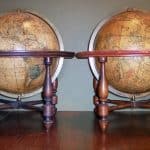
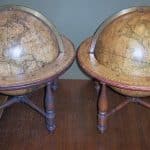



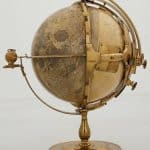
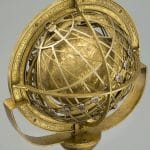
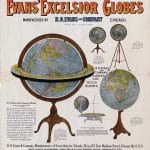

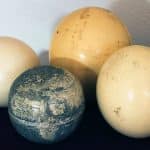



Related posts: